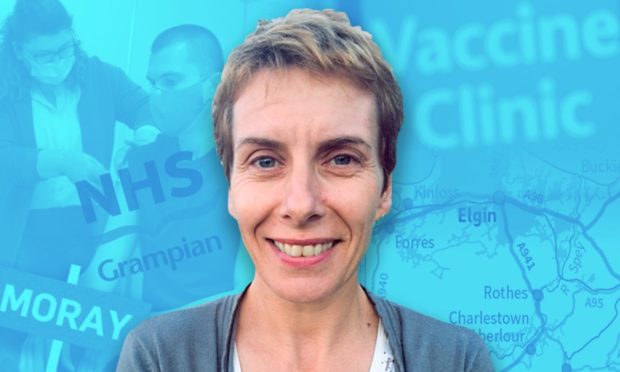The surge in Aberdeen Covid cases could still pose “serious disruption” to the NHS, health bosses are warning, despite the vaccine roll-out lessening the severity of illnesses.
The number of people requiring hospitalisation due to the virus in the north-east has been increasing on a week-to-week basis, with patients typically younger and yet to receive both jabs.
Dozens of new infections are being reported in Aberdeen every day, compared to single-digit increases in neighbouring Aberdeenshire and Moray.
NHS Grampian’s head of health intelligence, Jillian Evans, said you “could be forgiven” for thinking the north-east figures are not a concern in comparison to others parts of Scotland, but warned the situation could still spiral out of control.
“We’re looking at really early warning signs – at numbers of cases but also other indicators, such as the number of clusters we pick up,” she said.
“And what we’re seeing is a more worrying situation in the city than in Aberdeenshire.
“We’re seeing people being infectious in lots of different places – particularly workplaces, in sectors like hospitality and healthcare, and in households.
“It’s fairly widespread and there are a few areas where the rates are really high, so we’re concentrating a lot of effort there to encourage people to come forward to be tested.
“It’s a situation we’re trying to act on quickly.”
‘Notable increase’ in demand for healthcare
The likes of GPs have already experienced a “notable increase” in demand for their services, with people heading to them as a first port of call when experiencing Covid symptoms.
The number of people being admitted to hospital as a result of the pandemic has also been rising.
Ms Evans said health chiefs are considering more than just the headline figures when assessing the potential severity of the situation.
She added: “When you look at what’s happening in primary care and GPs – people’s first port of call when they become unwell – we’ve definitely seen a rise in demand for care.
“And there has been an increase in admissions, but we’ve still got very low numbers in hospital overall.”
NHS bosses have noted that people being admitted are largely younger and yet to receive both doses of the vaccine.
But, in line with this, they are not needing to stay in the wards for as long as other patient groups have previously.
Risk of ‘severe disruption’
Ms Evans said: “I think the main thing is not to be overly reliant on hospitalisations as a measure of how difficult the situation could become.
“The vaccines are doing their job at dealing with serious illness.
“The people that we’re seeing in hospital predominantly are people who aren’t fully protected with two doses.
“But even a rise in infections to the extent that we’re seeing – and we could see as more restrictions ease – could lead to serious disruption of health services, particularly in primary care and A&E, even if they don’t translate into people being seriously unwell enough to be admitted.”
In the longer term, this could lead to renewed significant pressures on the NHS.
“If cases across Scotland increase to the extent they could, as many modellers are proposing, we could see demand for health and care services that would be really difficult to sustain,” Ms Evans added.
“Particularly in primary care and A&E – and the sheer level of disruption in people’s lives.
“If you have such an increase in cases, and people needing to stay at home because they’re infectious, you could see quite a significant effect on sickness levels in any workplace.
“Any situation and any setting is vulnerable to the effects of a rise in infections.”
Why Aberdeen?
When looking at the data behind the pandemic, health chiefs have noticed infection spreading in “a lot” of different city workplaces, including offices and the hospitality sector.
It is thought this is partly due to the region’s move to Level 1 coronavirus measures, allowing for more freedom when meeting others.
Ms Evans said: “As the easing of restrictions has occurred, then people are freer to mix and that’s really what’s causing it.
“Aberdeen city is where people go to socialise and go to work, so it’s probably no surprise.
“And it’s predominately in the younger age groups we’re spotting people with symptoms – under 35s and so on – those who are liable to me mixing.”
She added: “We’re keen to emphasise the position is still that, if you can work at home then try to do it.
“And if you can’t work from home all of the time, try to do it for some of the time.
“There is a factor with people being in closer proximity – urban settings are more at risk than others.”
What can be done?
People across the north-east are being encouraged to take regular Covid tests, regardless of if they feel unwell or not.
Asymptomatic tests can be ordered through the UK Government website, or taken at one of several centres across Scotland.
This will help identify people who have caught the virus but are unaware, allowing them to self-isolate and avoid spreading it to others.
Ms Evans said: “Everybody can do something to reduce the risk here – whether that’s not going shopping as often, or seeing as many people you want to see, or keeping clear of people who are more vulnerable.
“People may not need to be fully compliant all of the time, but even being compliant to some extent is better than not at all.
“Every individual can help to reduce this situation and certainly things seem to be heading upwards, rather than going in the better direction.”
